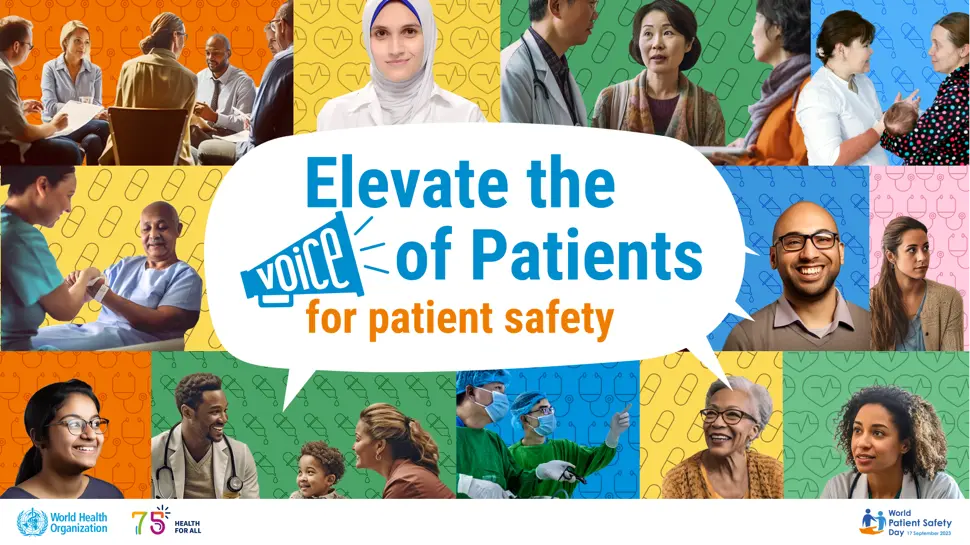The theme of World Patient Safety Day 2023 on September 17 is “Engaging Patients for Patient Safety” to recognize the crucial role patients, families, and caregivers play in the safety of healthcare. Evidence shows that when patients are treated as partners in their care, significant gains are made in safety, patient satisfaction, and health outcomes. By becoming active members of the healthcare team, patients can contribute to the safety of their care and that of the healthcare system as a whole.
Through the slogan “Elevate the voice of patients!” WHO calls on all stakeholders to take necessary action to ensure patients are involved in policy formulation, represented in governance structures, engaged in codesigning safety strategies, and active partners in their own care. This can only be achieved by providing platforms and opportunities for diverse patients, families, and communities to raise their voices, concerns, expectations, and preferences to advance safety, patient centeredness, trustworthiness, and equity.
WHO established World Patient Safety Day in 2019 as a global public health day with the adoption of resolution WHA72.6 (“Global action on patient safety”). Its objectives are to increase public awareness and engagement, enhance global understanding, and work toward global solidarity and action by member states to enhance patient safety and reduce patient harm.

World Patient Safety Day Webinars
WHO World Patient Safety Day 2023
World Patient Safety Day is one of WHO’s global public health days. It was established in 2019 by the Seventy-second World Health Assembly through the adoption of resolution WHA72.6 – “Global action on patient safety”. Global public health days offer great potential to raise awareness and understanding of key health issues and to mobilize support for action, from the local community to the international stage. World Patient Safety Day is firmly grounded in the fundamental principle of medicine – “first do no harm”. Its objectives are to increase public awareness and engagement, enhance global understanding, and work towards global solidarity and action by Member States to promote patient safety. Each year, a new theme is selected to highlight a priority patient safety area for action.
Patient Safety Facts:
- Evidence shows that when patients are treated as partners in their care, significant gains are made in safety, patient satisfaction and health outcomes.
- By becoming active members of the health care team, patients can contribute to the safety of their care and that of the health care system as a whole.
- The impact of meaningful patient engagement is remarkable, with studies showing a potential reduction in the burden of harm by up to 15%, saving countless lives and billions of dollars each year.
Campaign Key Message:
Safe health care is a fundamental right of all patients, everywhere, every time. And yet, patient harm due to unsafe care is one of the leading causes of death and disability worldwide, with millions of patients harmed every year.
Key Facts on Quality Health Services:
- In high-income countries, it is estimated that one in every 10 patients is harmed while receiving hospital care.
- The harm can be caused by a range of adverse events, with nearly 50% of them being preventable.
- Each year, 134 million adverse events occur in hospitals in low- and middle-income countries (LMICs), due to unsafe care, resulting in 2.6 million deaths.
- Globally, as many as 4 in 10 patients are harmed in primary and outpatient health care. Up to 80% of harm is preventable.
- The most detrimental errors are related to diagnosis, prescription and the use of medicines .
- Investments in reducing patient harm can lead to significant financial savings, and more importantly better patient outcomes.
- Inadequate quality of care imposes costs of US$ 1.4–1.6 trillion each year in lost productivity in Low-Middle Income Countries.
PSMF Fellows Celebrating World Patient Safety Day
What Quality Health Services Should Be:
- Effective by providing evidence-based health care services to those who need them.
- Safe by avoiding harm to the people for whom the care is intended.
- People-centered by providing care that responds to individual preferences, needs and values, within health services that are organized around the needs of people.
- Timely by reducing waiting times and sometimes harmful delays for both those who receive and those who give care.
- Equitable by providing the same quality of care regardless of age, sex, gender, race, ethnicity, geographic location, religion, socio-economic status, linguistic or political affiliation.
- Integrated by providing care that is coordinated across levels and providers and makes available the full range of health services throughout the life course.
- Efficient by maximizing the benefit of available resources and avoiding waste.
- Many of the above domains of quality are intimately related to ethical principles.












